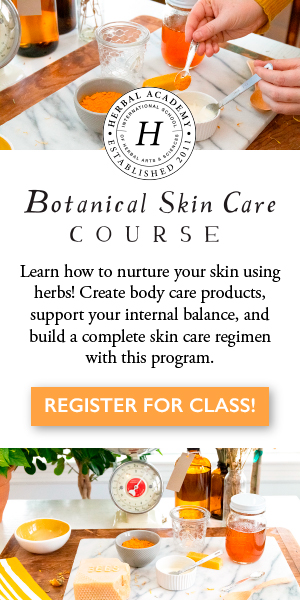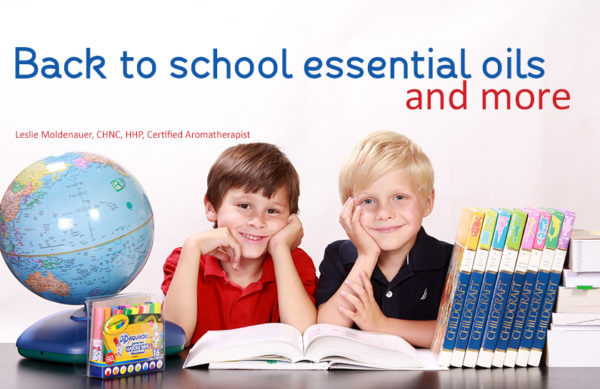
by Leslie Moldenauer | | Essential Oils
As children everywhere let out collective moans and groans, and parents secretly smile…mixed with a little bit of nostalgia, it is time to send them back to school. This is the time when the Internet and social media starts exploding with ‘top essential oils for back to school’ type posts as well. I will be sharing some of those here too, but I would be doing all of my readers a disservice if I did not approach wellness from a different angle. There are many things that we parents can be doing on a day-to-day basis to lessen the chances of illness or repeat illness that often gets overlooked. Back to School Essential Oils and More!
The three main staples of hydration, rest and hand washing are critical! You could do everything I mention in this article today, but if your child is touching desks, tables, door handles, and every other imaginable surface at school and not washing their hands multiple times a day, with soap, for a proper length of time..some say as long as it takes to sing happy birthday, best of luck to ya.
So, work on those three. My youngest tries to skip out on hand washing, heck he is even the kid to wet his hands briefly to show me, see they are wet! (he has been caught in the shower doing this too….KIDS) I remind him how shitty feeling shitty feels…albeit gently as I can, no mommy dearest antics over here…and he tries to do better.
What else can parents do? Quite a lot actually.
#1 Vitamin D-The sun is our friend. Research suggests three-quarters of U.S. teens and adults are deficient in vitamin D… leaving them with less-than-optimal health [1].
Your skin naturally produces your body’s supply of vitamin D from direct exposure to bright midday sun with a mere ten or fifteen minutes’ exposure per day. What is one of the symptoms of low Vitamin D? You guessed it….a greater incidence of cold and flu.
Taking a low amount of Vitamin D is perfectly safe if you are not able to get this amount of sunshine a day. It is said that fair-skinned individuals, especially redheads, can absorb and utilize Vitamin D much easier than others. Where you live also plays an important part. The closer to the equator you live, the better.
*Since Vitamin D is NOT a water-soluble vitamin, please be sure to get your Vitamin D levels checked by your doctor before taking large amounts via a supplement.
#2 Eat a healthy diet– Eating healthy will boost your immune system. Eat plenty of vegetables, fruits, nuts, and seeds which will provide your body with the nutrients your immune system needs. Simply put, illness and dis “ease” thrives on sugar. Consuming too much sugar suppresses the immune system cells responsible for attacking bacteria.
#3 Probiotics– Probiotics are a form of healthy gut bacteria. Their job is to stimulate naturally forming enzymes in the gut to keep out digestive system happy and healthy, and to keep us well. Keep your gut flora in check and in good balance by consuming plenty of fermented foods or by taking a quality daily supplement. Here is the one I use for my children.
#4 Echinacea– Echinacea stimulates the body to produce more infection-fighting white blood cells, such as T-lymphocytes and killer white blood cells [2]. Echinacea also seems to search out and destroy some viruses, such as the common cold and flu viruses. There have been many studies performed on echinacea with mixed results. Some say that echinacea should be used periodically as a preventative, others say use echinacea when you get sick. Do some research for yourself!
*Echinacea is NOT for you if you have an autoimmune condition such as lupus, rheumatoid arthritis, or diabetes. I recommend taking it for no more than 2-4 weeks, respectively, without taking a break.
Read more on echinacea here.
Most health food stores have Echinacea in a tincture form either on its own or combined with astragalus, another great herb for an immune boost. You can also buy this on Amazon, like here and here. Add the dose to their juice in the morning, or a glass of water right before bed.
#5 Elderberry Syrup– Used for its antioxidant activity, boosting the immune system, and is great for coughs, colds, and flu, elderberry syrup is a must have in your home. There is research to back up this powerful little berry, here is one study on PubMed. Elderberries contain amino acids, carotenoids, flavonoids, vitamins A and B and a large amount of vitamin C. They are also mildly laxative, a diuretic, and diaphoretic. Flavonoids, including quercetin, are believed to account for the therapeutic actions of the elderberry flowers and berries.
Here are some additional studies that speak to the benefits of elderberry. You can purchase at your local CVS, Walgreens, or buy on Amazon. I prefer to make my own.
*Kong F. Pilot clinical study on a proprietary elderberry extract: efficacy in addressing influenza symptoms. Online Journal of Pharmacology and Pharmacokinetics. 2009;5:32-43.
*Roschek B, Fink RC, McMichael MD, et al. Elderberry flavonoids bind to and prevent H1N1 infection in vitro. Phytochemistry. 2009;70:1255-61
*Ulbricht C, Basch E, Cheung L, et al. An evidence-based systematic review of elderberry and elderflower(Sambucus nigra) by the Natural Standard Research Collaboration. J Diet Suppl. 2014;11(1):80-120.
*Zakay-Rones Z, Thom E, Wollan T, Wadstein J. Randomized study of the efficacy and safety of oral elderberry extract in the treatment of influenza A and B virus infections. J Int Med Res. 2004;32:132-40.
#6-Great First Essential Oils to Support Wellness
Chamomile Roman (Anthemis nobilis)
Go stand in the middle of an apple orchard and close your eyes, take a big deep cleansing breath. You are smelling Roman Chamomile. R. Chamomile is very high in esters, therefore it is a very calming essential oil. It is also very soothing to irritated skin of all varieties and is a great tummy soother.
Lavender (Lavandula angustifolia)
The aroma of Lavender is fresh and sweet, floral and slightly herbaceous. Lavender is superior for supporting mental wellness, promoting a good night sleep, supporting a healthy stress response, and is great to soothe sun-kissed or irritated skin.
*Special note: Lavender is a favorite of many and used often, therefore, we should pay attention to how much we are using it (As we really should with any oil we use). Less is more.
Lemon (Citrus limon)
Lemon smells amazzzing! Super sweet, fresh, and fruity. Due to the phototoxic risk of this essential oil, I recommend diffusing only unless you are very well-versed in how to use oils topically that are phototoxic.
Diffusing lemon essential oil is a great support for a healthy immune system. It can also be utilized in school-aged children as a pick them up to get them started in the morning, or just to alleviate “Grumpy Gus” syndrome.
Orange (Citrus Sinensis)
This is by far the most used oil in my household. It calms my 12-year-old like no other oil. It is known as both uplifting for the mood, yet calming on the nervous system. Lavender is often called the Swiss Army® knives of essential oils, but I can easily apply that term here as well for sweet orange. Sweet orange is not photo-toxic to the skin, yay!. A few other varieties are Bitter orange Citrus aurantium var. amara, Wild orange Citrus sinensis (L.) Osbeck and Blood orange Citrus sinensis (not all-inclusive).
Steam distilled vs cold-pressed is often misunderstood when it comes to photo-toxicity. If you are unsure what you have, please reach out to your essential oil provider.
Mandarin Red (Citrus nobilis)
This is hands down one of my favorite citrus essential oils. Citrusy and tangy, super sweet and fresh. I would diffuse this oil when my oldest (probably 3 at the time) was going through a “Mom don’t you dare leave this room” phase. I would sit and rock him and Mandarin would have him resting in no time, but is great for all ages.
Mandarin Red is a superior, mood-lifter, and promotes all the happy go lucky feelings of being a kid. It is a great addition to a diffuser blend when under the weather, supporting a quicker recovery by providing comfort. Helps to calm thoughts so sleep can come. This essential oil is not phototoxic.
Rosalina (Melaleuca ericifolia)
Rosalina is herbaceous, medicinal, robust, warm, and slightly spicy.
There are even times when our little ones need assistance to push their bodies toward homeostasis. They need support. It is important to note that essential oils are not a cure, but there are times where essential oils are called on to give the immune system a little extra oompf. Rosalina can be used here.
A powerhouse for supporting a healthy respiratory system, Rosalina is a great oil for kids, has calming properties like Lavender as well as is soothing to skin bites and various irritations like tea tree. A very well-rounded essential oil, and a must-have for your wellness kit.
*Special note: If you are utilizing Rosalina between the ages of three months to one year to support a healthy respiratory system, I recommend light diffusing only. Save must-have topical use for Chamomile Roman, Lavender and Mandarin Red.
Respiratory Support
Most (not all) back to school illness needs some form of respiratory support. I do not hesitate to use the big guns like Eucalyptus, but seeing as many of my readers are newer to essential oil use, here are a few oils that you can use to provide the support you are looking for, without having to reach for Eucalyptus if you have concerns about doing so.
Cedarwood Atlas (Cedrus Atlantica)
Cedarwood Atlas is a great oil to support respiratory wellness and is safe for kids. Cedarwood can help to reduce spasms, address spastic coughs, and is an expectorant helping to combat phlegm. It is a great aroma for fall and winter, so in a diffuser, it has a dual purpose.
Here is a great blend for your diffuser when needed:
Cedarwood Cedrus atlantica 3 drops
Cypress Cupressus sempervirens 2 drops
Sweet Orange Citrus sinensis 5 drops
*This amount is suitable for a 400ml water reservoir diffuser. Adjust accordingly.
Fir Needle/Siberian (Abies sibirica)
The uplifting forest-fresh scent of Fir Needle supports a healthy respiratory system. Fir Needle helps ease congested breathing associated with typical seasonal illness. I feel this essential oil is a fantastic replacement for oils high in 1,8 cineole.
Steam Tent for Respiratory Support
Master blend
Fir Balsam 5 drops
Rosalina 5 drops
Spruce 5 drops
Pine (Pinus Sylvestris)
Pine is known for its ability to help support a healthy respiratory tract, and in a diffuser helps to clear/cleanse the air. It is also a powerful addition to cleaning products to help purify the home. You can add Pine to Lemon essential oil in a spray bottle if Pine-sol is a scent that you love. Make sure if only using essential oils and water than you use it quickly without a preservative.
I have given you a lot to think about today, if you have any questions, you can reach out to me anytime at Lifeholistically@gmail.com.
References
[1] Demographic Differences and Trends of Vitamin D Insufficiency in the US Population, 1988-2004. Retrieved from
https://jamanetwork.com/journals/jamainternalmedicine/fullarticle/414878
[2] Benefits, uses, and side effects of echinacea. Retrieved from https://www.medicalnewstoday.com/articles/252684.php
*There are affiliate links within the article. You do not pay any more for the suggestions made.


by Leslie Moldenauer | | Essential Oils
I was honored to work with the Association of Placenta Preparation Arts to write a piece about the safety concerns surrounding using essential oils in the encapsulation process.
Here is a link to the original article, if you are considering placenta encapsulation, please contact a professional with the APPA®.

By, Leslie Moldenauer, CHNC, HHP, Certified Aromatherapist
The placenta is a beautiful and integral organ of life. It is the vital force for your baby, taking the role of sole support at the end of the first trimester of pregnancy until birth. The placenta has a number of important roles, and now it is being shown to have amazing benefits for mom after giving birth as well.
Birthing the placenta is considered the third stage of delivery, and many moms are now choosing to encapsulate their placenta to consume it mere hours after giving birth. What is placenta encapsulation? How is it done and is it safe? Are their benefits to the new mother?
What are the benefits?
Consuming the placenta after birth has shown to be really beneficial for the health of mom in numerous ways.
It is stated that consuming the placenta after birth is incredibly helpful at lowering the risk of postpartum depression, at providing sustained energy and aiding in the uterus returning to its post-pregnancy state [1].
“We surveyed 189 females who had ingested their placenta and found the majority of these women reported perceived positive benefits and indicated they would engage in placentophagy again after subsequent births. When asked to describe any positive effects experienced, the majority of women in the sample claimed that they experienced improved mood as a result of consuming their placenta postpartum (40%). The second most frequently given response to this question was increased energy/decreased fatigue (26%). Women also reported benefits related to improved lactation (15%) and alleviated postpartum bleeding/discharge (7%)”[2].
The rates of women who are affected by postpartum depression (PPD) are staggering, and constantly on the rise. According to a study performed in 2017 by the CDC, approximately one in nine women currently experience symptoms of PPD [3]. These numbers are very significant. It is encouraging that consuming the placenta can be beneficial.
*If you think you may be suffering from PPD, please see your doctor.
Consuming the placenta after birth is also noted to assist lactating mothers with milk production.
“Powdered Placenta Hominis was used for 57 cases of insufficient lactation. Within 4 days, 48 women had markedly increased milk production, with the remainder following suit over the next three days” [4].
We can see that there are possible benefits to consuming the placenta after birth. Preparation is very specific, by professionals that are highly trained. These include meeting OSHA laws and regulations [5] and being trained in bloodborne pathogen safety. It is equally important to have quality liability insurance.
Many individuals that have chosen to do this work do it as a part of an adjunct to their main niche. Many have added placenta encapsulation to their existing services as a doula or midwife.
The method of placenta encapsulation
If you are considering placenta encapsulation, make sure you find someone that adheres to very high standards, such as encapsulators who have been through a training program like APPA (Association of Placenta Preparation Arts). All surfaces and equipment used should be sanitized meticulously with a bleach solution and rinsed thoroughly. Because of the risk of bloodborne pathogen transmission, strict sanitation guidelines should be followed. Certifying organizations like APPA have encapsulators following OSHA regulations and their own additional safety protocol for the benefit of clients and professionals alike.
There are currently two methods of encapsulation. The first is the Raw Start method.
*The following information regarding methods is paraphrased from the website findplacentaencapsulation.com [6]
Raw Start method
The preparer slices up the placenta and places it into a high-quality food dehydrator until it is fully dried. It is then powdered and placed into capsules.
This gives a higher yield than the second method. Because the placenta is not steamed prior to dehydration there may be a slightly increased risk of harmful bacteria.
TCM (Traditional Chinese Medicine) method
In this method, the placenta is steamed for approximately 30-45 minutes before being sliced and placed into the dehydrator. TCM has a long-standing belief of balance in all things. In the TCM model, good health and balance is believed to be due to a balance of yin, which is considered negative, dark and feminine, and yang, which is positive, bright, and masculine [7]. This method of encapsulation is then thought to balance the yin and yang of the placenta. An encapsulator utilizing this method should have some level of training in TCM, or at least training in the history and methodology behind it. The traditional method steams the placenta using primarily lemon, ginger, and hot pepper in the water. Some practitioners may opt for additional herbs or none at all. None of these are actually encapsulated with the placenta for consumption. In addition to balancing yin and yang properties/energies, steaming the placenta also kills off a myriad of microbes.
You will yield less volume of powder in the end, as steaming the placenta shrinks it considerably. Another possible con is that utilizing foods and herbs could potentially increase the likelihood of an allergic reaction in food sensitive women. A thorough consultation with the mother is therefore recommended.
So, in light of this, what could some possible issues be in adding essential oils to the steaming water in the TCM method?
What we need to know about essential oils
Essential oils are derived from the various parts of the plant, most often by steam distillation. Therefore, they are highly concentrated extracts that are approximately 75-100 times more concentrated than dried herbs [8]. Very little essential oils should be used compared to fresh or dried herbs in any application.
Aromatherapy educator Andrea Butje of Aromahead Institute states that “it takes anywhere from 30-50 blossoms to produce one single drop of Rose Otto Essential Oil” [9]. According to the Essential Oil Company, rose is a very low yield of approximately 0.006% [10].
In comparison, Peppermint essential oil has a yield of anywhere from 1.0-2.5% [11], still very low. Why am I making a point to reference these percentages? To illustrate just how concentrated essential oils are. Because of this concentration, we must use extreme caution when we use them. Many essential oils should not be used immediately before or after surgery, when taking medications, if there is a blood clotting issue present, when an individual has a weakened constitution and a whole host of other considerations. Aromatherapists have to analyze all of this before we recommend utilizing essential oils in any manner, especially after giving birth.
What are other risks of using essential oils in placenta preparation?
Essential oil enthusiasts and practitioners alike know that there is a great benefit to what is called a steam tent, or steam bowl with essential oils. This is generally utilized for times where respiratory support is needed. It is performed by heating up a pot of water, below a boil, then pour the water either into a sink or bowl, adding a couple drops of essential oil and covering your head with a towel and inhaling the therapeutic steam.
Essential oils are helpful in this manner via direct inhalation, but can we assume that the placenta would benefit as well?
Adverse effect/allergy
As I mentioned above, it is known that specific essential oils, or oil constituents, come with cautions and contraindications when specific medical conditions are present or medications are being taken [12]. When essential oil molecules are present in the air of the steam, the placenta will absorb these constituents, possibly causing an issue when taken internally, much like that mother above with food sensitivities. It is simply not worth the inherent liability.
Adulterated essential oils
Not all essential oils are created equal. There are numerous chemists that test essential oils for purity due to the rising number of essential oils companies, and subsequently, we are finding many on the market to be less than stellar in their contents and composition. There are inferior products that have been adulterated or extended with a vegetable-based carrier oil, alcohol, an emulsifier, or even cheaper oil with a similar chemistry. Adulterated essential oils would definitely be detrimental to the encapsulation process.
Another consideration to use
Some new moms opt to receive the steaming water to be taken internally as a broth for additional nourishment. This is another very important reason to keep essential oils out of the water, as we know that oil and water do not mix. Please do not consume essential oils internally without a thorough consultation from a qualified aromatherapist trained in this area.
APPA (Association of Placenta Preparation Arts) standards
APPA® provides the broadest and most comprehensive training in placenta preparation in the world, considered the “Bachelor’s Degree in Placenta Arts” [13]. The training has been prepared by the industry’s pioneers with many years of experience, which have collaborated their collective wisdom to teach and empower others. APPA® does not condone the use of essential oils in the art of placenta preparation.
Closing
Risk versus benefit must always be considered in any intervention that we embrace for the betterment of our health. There are many risks and no known benefits to the practice of using essential oils in the preparation of your placenta.
Please do your research when seeking out a qualified practitioner to guide you if you are considering this time-honored tradition.
References
[1] Selander, J., Cantor, A., Young, S. M., & Benyshek, D. C. (2013). Human Maternal Placentophagy: A Survey of Self-Reported Motivations and Experiences Associated with Placenta Consumption. Ecology of food and nutrition, 52(2), 93-115.
[2] Homes, Peter. (1997). Jade Remedies. Snow Lotus Press, 352.
[3] Trends in postpartum depressive symptoms-27 states, 2004, 2008, and 2012, Retrieved from https://www.cdc.gov/mmwr/volumes/66/wr/mm6606a1.htm?s_cid=mm6606a1_w
[4] Bensky/Gamble. 1997. Materia Medica, Eastland Press, 549.
[5] OSHA Laws and Regulations. Retrieved from https://www.osha.gov/law-regs.html
[6] Methods of Encapsulation. Retrieved from http://findplacentaencapsulation.com/placenta-encapsulation-methods/
[7] Yin and Yang Theory. Retrieved from https://www.tcmworld.org/what-is-tcm/yin-yang-theory/
[8] How Concentrated are Essential Oils. Retrieved from http://www.labofflowers.com/answersbook6.html
[9] Andrea Butje. (2017) The Heart of Aromatherapy. Carlsbad, CA: Hay House, Inc., p. 6]
[10] [11] Percent yield guide for essential oil distillation. Retrieved from https://www.essentialoil.com/pages/percentage-yield
[12] Tisserand, R., Young, R., & Williamson, E. M. (2014). Essential oil safety: A guide for healthcare professionals. Edinburgh: Churchill Livingstone/Elsevier.
[13] Association of Placenta Preparation Arts. Retrieved from https://placentaassociation.com/

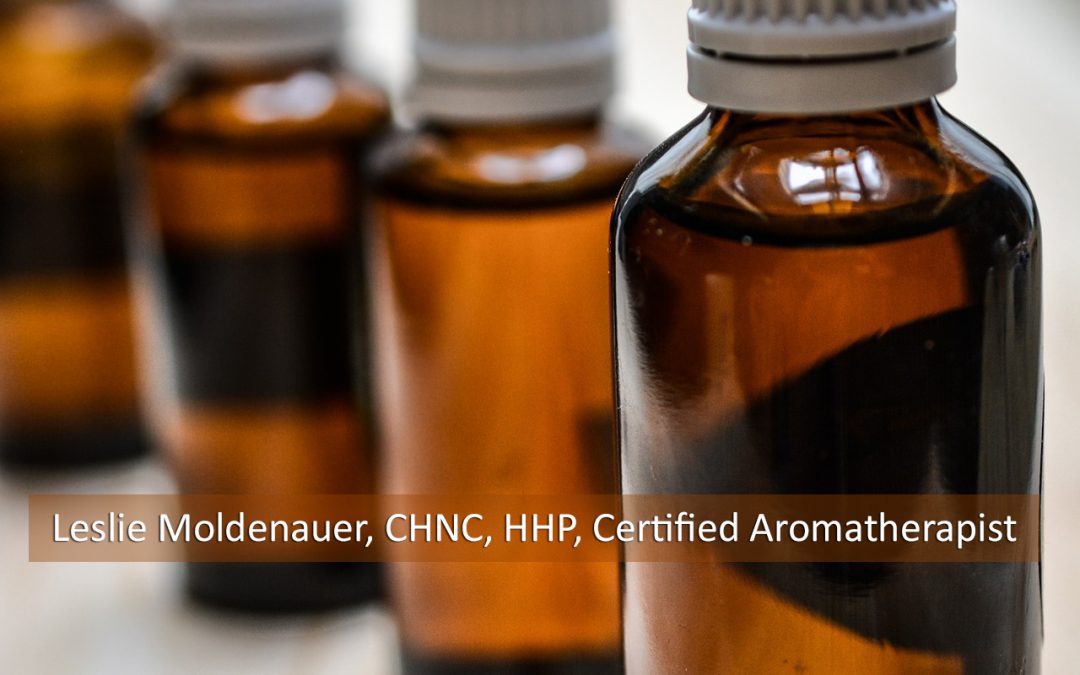
by Leslie Moldenauer | | Essential Oils
You will be able to find a plethora of articles on the internet regarding essential oils, consequently, there are many myths surrounding them. There are many opinions regarding essential oil safety as well. Some have even become fanatical about the advice (which does not feel authentic to me), shaming others online as a means to teach them. Anyone that has followed me over the years knows that safety is in fact very important to me, but I will never shame you for the choices you have made in the past, ones you are making today, or if you choose not to take the advice you have read today. My job is to help guide you, and you choose to take on whatever resonates with you. This is how we learn. 3 Common Yet Risky Essential Oil Mistakes…..
The widespread marketing of two popular brands of essential oils has introduced many people to these powerful tools for health which is a real blessing. With it comes a few concerns. The first being the unsafe recommendations for use that is seen on blogs, Pinterest, as well as Facebook pages. Essential oils are not to be used carelessly, and misuse can lead to injury. The second is sustainability. So many are of the vein of ‘buy all of the oils’, and that can be really problematic for the future of our precious oils.
Just as you would (or should) exercise caution and research when using pharmaceuticals, you should practice the same careful research when using essential oils. Essential oils are profoundly powerful, which makes them capable of powerful healing, but also injury when used improperly. Overuse and misuse can and does lead to injury.
1. Diluting Essential Oils
Essential oils are very concentrated extracts, much more concentrated than the plant material that it is derived from. Since they are so concentrated, they need to be diluted before they are safe to apply to the skin.
When used undiluted or what some call “neat” there are two risks involved:
1-Irritation which is a direct result of contact with a material and is localized. Healing occurs once the material is removed. Removal is best with a carrier oil (almond, jojoba, etc.) or milk. Follow up with warm soapy water, then add more carrier oil if needed. Healing may not occur immediately, but you should see and feel improvement after proper removal.
2-Sensitization which is a systemic response involving the immune system. According to Dorene Petersen, president of the American College of Healthcare Sciences (ACHS):
“Sensitization occurs once the offending substance has penetrated the skin, been picked up by proteins in the skin, and mediated by the IgE response that produces histamine and other irritants” [1].
This is an allergic reaction. Some oils are more likely than others to elicit this sensitization response, such as lemongrass and cinnamon bark….but it can happen even with oils that some consider gentler oils such as lavender and peppermint. Once this immune system response is triggered, that may mean you can never use that oil again. Never! Compare this to a nut allergy. Not worth the risk!
Please do not subscribe to the “detoxing” explanation where skin irritation is concerned, this is simply not true. If you get a rash or a burn from putting something on your skin is it because it is irritating your skin. Unfortunately, the detox reaction is still being shared as a viable explanation for a rash, and innocent people are being injured. Sometimes by applying more essential oils to the irritated area. Please hear me when I say, skin irritation that can result from essential oils is NOT a detox reaction at all. There is good news in all of this though, and that is when you properly dilute your essential oils, the risk of any irritation is greatly reduced.
Check here for a detailed explanation on this topic from my friend and colleague Liz Fulcher, owner of the Aromatic Wisdom Institute.
2. Internal Use
Essential oils are not water soluble. Oil and water do not mix/blend. They need a dispersant before adding to your bath water (carrier oil); Epsom salts alone is not enough.
Please do not add essential oils to a glass of water and drink it.
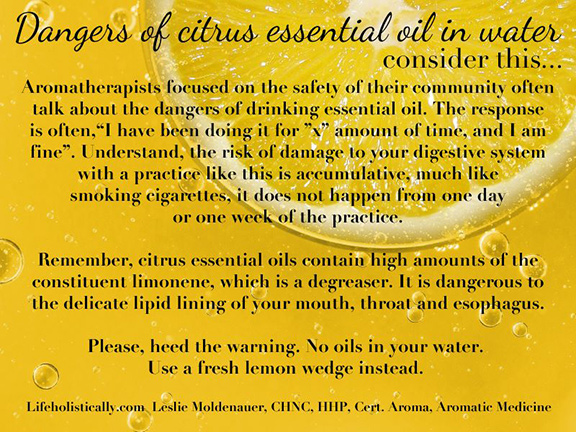
When you add a drop of oil to a glass of water it doesn’t mix with the water. The risks are not worth the practice. Oral dosing may interfere with medication or aggravate other medical conditions. Please refer to the 2014 book, Essential Oil Safety 2e by Robert Tisserand and Robert Young to learn which essential oils carry the most risk internally when taking daily medication.
You may hear something like “our oils are pure therapeutic grade and are safe for internal use” or “certain oils are GRAS” (generally recognized as safe for consumption), but this applies to consuming in food (food additives); not in water. Follow the link here for an informative article by my friend and colleague, The English Aromatherapist about what GRAS really means.
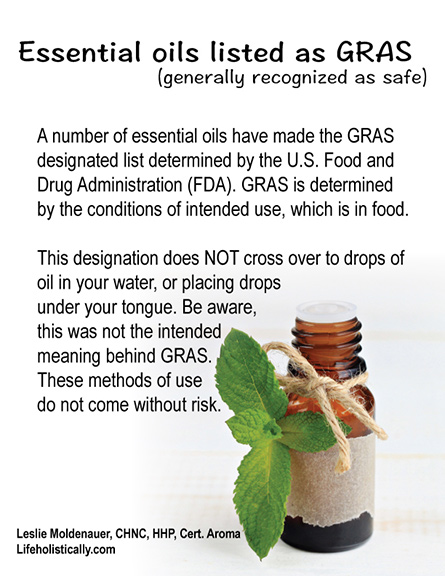
Essential oils can be safe for internal use under certain circumstances when under the care of a professional; someone who has been trained, ultimately much more than the basic 200 hour foundation training, and has to understand how these oils react inside the body, if it is necessary for your condition, and most of all if it is safe and indicated for you and your situation (medication, medical conditions, allergies, etc.). Look for someone such as myself who has been trained in aromatic medicine. Not all aromatherapists have this level of training.
More on Internal Use…
Internal use is not meant to be an everyday practice. It is not to lose weight, ease indigestion, or to be used as a preventative measure to maintain health. That is where healthy eating, exercise, sleep, vitamins, and minerals come into play when you are deficient. Essential oils have no “nutritional value”; another myth. Read more on these topics here and here.
Just to reiterate so that my stance is clear, I am NOT against internal use of essential oils. I am against the methods that are recommended online that are risky, such as oils in water, directly under the tongue, and in a capsule without a carrier oil. Not safe.
3. Over Diffusing of Essential Oils
If a little bit works, more is not necessary. This applies with topical use, and diffusion as well.
Essential oil diffusers disperse the essential oil into the air in tiny droplets. Robert Tisserand recommends diffusing times of 30-60 minutes, or 30 minutes on and 60 minutes off [2]. If you are diffusing in a small room, make sure to have proper ventilation. I think Tisserand’s recommendations may be generous when looking at small children, therefore, I will go one step further to say that if you are diffusing for a small child, 15-20 minutes on and 60 minutes off will be more than sufficient for them. If you decide to diffuse for a baby, six months or older, 10 minutes will likely be just enough.
When we inhale too much of a good thing, we can have adverse effects. Tisserand stated in his book, Essential Oil Safety 2e, “prolonged inhalation (more than about 30 minutes) of concentrated essential oil vapors (e.g., steam inhalation or direct from a bottle) can lead to headaches, vertigo, nausea and lethargy” [3].
You can also experience an overall feeling of being unwell marked by malaise or disorientation, or even heartburn. I get heartburn from diffusing cinnamon (Cinnamomum zeylanicum).
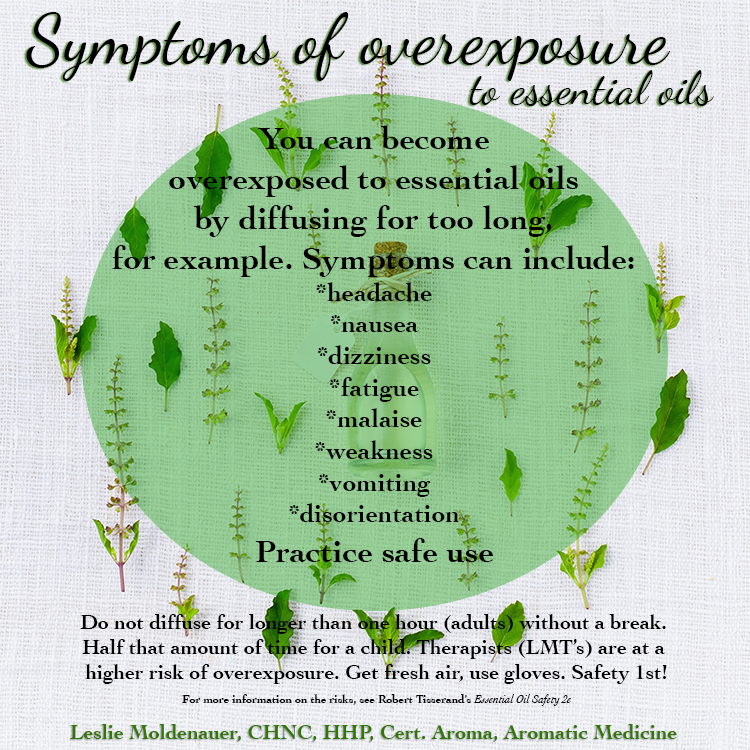
The good news is that when we follow basic safety advice, any risk of utilizing essential oils is greatly reduced. If you have any questions about essential oil safety, please reach out to me @ Lifeholistically@gmail.com.
References
[1] American College of Healthcare Sciences, (2012) Aroma 101
[2] [3] Tisserand, R., Young, R. (2014) Essential Oil Safety (2nd Ed)

Like so many practices in life, I encourage you to become educated on the proper use of essential oils. When using them, please do so cautiously, understanding that there is often misinformation on the internet. You can be assured that I support only educated and proven resources. While essential oils should not be feared they should be respected and used properly to ensure the safety of the individuals using them.
Please note that I am not a medical practitioner. The content of this website is provided for general informational purposes only and is not intended as, nor should it be considered a substitute for, professional medical advice. Do not use the information on this website for diagnosing or treating any medical or health condition. If you have or suspect you have a medical problem, promptly contact your professional healthcare provider. By using this website, you assume full responsibility and liability for your own actions.
BEFORE YOU GO! Remember to sign up for my FREE Facebook group! Hang out with me and THOUSANDS of other Essential Oil lovers looking to learn, click on to join Real Essential Oil Education Group!
Check out my FREE offer below!
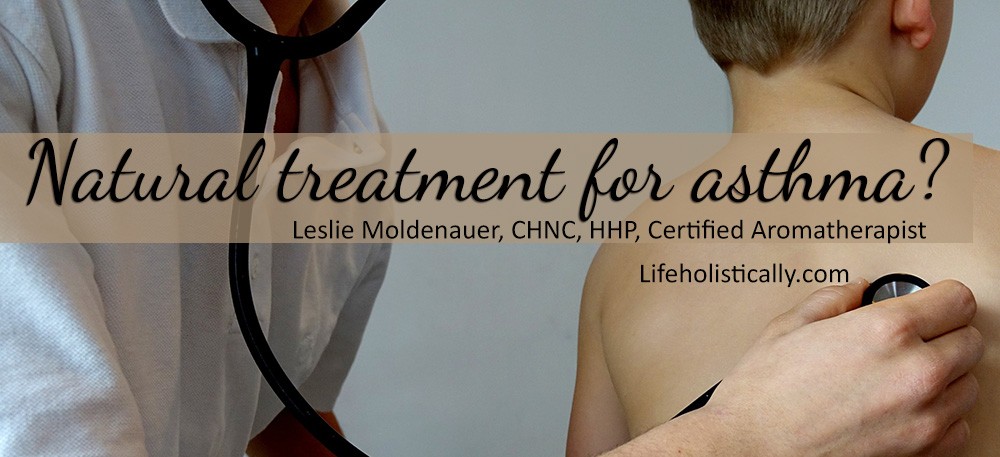
by Leslie Moldenauer | | Essential Oils
Should we be using essential oils for asthma relief
Asthma is a chronic inflammatory disorder of the airways typified by wheezing, tightness in the chest, and difficulty breathing, sometimes warranting emergency medical care [1]
There has been a sharp rise in the cases of asthma over the past decade.
According to the Centers for Disease Control and Prevention (CDC):
“About one in 12 people in the U.S. has asthma, or about 25 million people. And the rate appears to be on the rise. From 2001 to 2011, the CDC says the number of Americans with asthma grew by 28 percent” [2].
Note: Sufferers know that an acute asthma attack can be a medical emergency. For this reason, use extreme caution when trying a DIY recipe at home. Never replace essential oils for your inhaler in an emergency situation. Consult your physician or go to an emergency room.
There are two main types of asthma, extrinsic is typically from external allergens, causing the production of IgE proteins, and the subsequent release of histamines causing restricted airways and the difficult breathing that follows [3].
The second is intrinsic, or having an internal cause. Dr. Francis Rackemann, an expert in asthma, stated that these individuals would not test positive for external allergens on the infamous skin prick test [3]. Intrinsic asthma could be exacerbated by a cold, flu, or other respiratory illness, for example.
Pinpointing and avoiding triggering factors can minimize asthma attacks, but those that suffer know that is not an easy task as those triggers constantly change and/or evolve. Nevertheless, if the trigger can be isolated and removed, that would be the ideal scenario.
It is always recommended to get allergy testing to determine what environmental or food allergies are present. An elimination diet can also be helpful to determine which foods the client is intolerant to as these do not always show up on an allergen skin prick test. Pollen and dust are big triggers, as are smoke, pet dander and other various chemical sensitivities such as artificial fragrance and yes, even essential oils.
There are other proposed causes of asthma attacks such as the overuse of antibiotics. The University of British Columbia found that those prescribed antibiotics before their first birthday were more than twice as likely as untreated children to develop asthma [4]. If these children had multiple courses of antibiotics, the incidences rose even higher. The theory behind this finding is excessive hygiene, reducing or removing beneficial bacteria from the gut, which causes the body and immune system to go into overdrive causing these allergic-type reactions. Read more details in the study referenced below [4].
Holistic Approach
For those that suffer from the extrinsic type, a removal of exposure to allergens is an important first step. Murray and Pizzorno state in their book, The Encyclopedia of Natural Medicine, those allergens can be viewed as straws on a camel’s back, and by adding enough straws to the camel’s back it eventually breaks [5].
*Placing quality air filters in the home is a great start. This is the one that I utilize, with great results. Here is another unit with great reviews for asthma and allergy sufferer.
*Those that have allergy-induced asthma knows that the home can be even more precarious than the outdoors. Bringing plants into the home is very beneficial. Follow this article that I wrote all about the best plants to do the job.
*Have you ever tried a pink Himalayan salt inhaler? Salt caves have been used for centuries to reduce respiratory ailments [6]. *Note, this unit is meant for salt only, do not add essential oils.
*A study published in 1996 by the Medical Journal of Australia, showed that children who ate fish (more than once a week) have one-third the asthma risk of those who did not consume it [7]. This is my preference for my children, as they will only eat moderate amounts of fish.
*Licorice (Glycyrrhiza glabra) is highly regarded as an anti-inflammatory and has antiallergenic properties [8]. Research to make sure this root is safe for your use.
*The gum resin of Frankincense (Boswellia serrata) also has antiallergenic effects. A double blind placebo study published in 1998 showed that individuals treated with the resin of Boswellia serrata showed a 70% reduction in bronchial asthma after a 6-week treatment period. The control group showed an improvement rate of only 27% [9].
Essential oils
Essential oils can also be of great benefit. The issue that I see on the Internet and social media are that the recommendations are not always based on science but on ‘sharing what worked for me’ scenarios. The problem here is an essential oil that helps one asthmatic may be the very essential oil that causes another’s attack so I do not recommend DIY’s at all to find relief. Peppermint and Eucalyptus are two such examples of what works for one is an issue for another.
Note: Always have your inhaler in hand when trying an essential oil to calm your symptoms. Steam tents have been shown to aggravate more than help, therefore, I would avoid this method of use.
On that note, I would like to share one piece of research on the subject. A study published in 2007 by the European Journal of Pharmacology, tested the constituent trans-Caryophyllene (as well as humulene) and showed that this component may help to help manage/treat inflammatory diseases such as asthma [10].
Which essential oils contain higher amounts of this constituent? Copaiba (Copaifera officinalis) and Black pepper (Piper nigrum). (Resources)
*Some of you may be having a light bulb moment. Can CBD oil help? Although CBD is not my area of expertise, I recommend reaching out to my colleague Kayla Fioravanti of Ology Essentials, who is.
Whether looking at supplements, herbs, or essential oils, I strongly advise you to continue taking medication for asthma, these things are not recommended as a replacement. Medications should never be abruptly stopped. Please reach out to your pediatrician, allergist/immunologist, or pulmonologist to discuss adding any of these recommendations to your wellness plan.


References
[1] Global Initiative for Asthma Management and Prevention (2018) https://ginasthma.org/
[2] Asthma and Allergies on the Rise in the U.S. https://www.healthline.com/health-news/children-allergies-and-asthma-on-the-rise-110813
[3] Bottrell, J. (2016) Extrinsic –vs- Intrinsic Asthma https://asthma.net/living/extrinsic-vs-intrinsic/
[4] Marra, F et al (2006) Does antibiotic exposure during infancy lead to the development of asthma?: a systematic review and metaanalysis. Chest journal https://journal.chestnet.org/article/S0012-3692(15)52261-7/fulltext
[5] Murray, M. T., & Pizzorno, J. E. (2014). The encyclopedia of natural medicine. London: Simon & Schuster.
[6] What is halotherapy? https://www.thesaltcove.com/about/#bio
[7] Salome, H. et al (1996) Consumption of oily fish and childhood asthma risk. The Medical Journal of Australia https://www.ncbi.nlm.nih.gov/pubmed/8628130
[8] Shin YW et al (2007) In vitro and in vivo antiallergic effects of Glycyrrhiza glabra and its components. Planta Medica https://www.ncbi.nlm.nih.gov/pubmed/17327992
[9] Wildfeuer, A. et al (1998) Effects of boswellic aciss extracted from a herbal medicine on the biosynthesis of leikotrines and the course of experimental autoimmune encephalomyelitis. Arzneimittel-Forschung. https://europepmc.org/abstract/med/9689425
[10] Fernandes, E et al (2007) Anti-inflammatory effects of compounds alpha-humulene and (−)-trans-caryophyllene isolated from the essential oil of Cordia verbenacea. https://www.sciencedirect.com/science/article/pii/S0014299907005419
Resources
Gertsch, J. et al (2008) Beta-caryophyllene is a dietary cannabinoid. https://www.ncbi.nlm.nih.gov/pmc/articles/PMC2449371/
Rogerio, A. (2009) Preventive and therapeutic anti‐inflammatory properties of the sesquiterpene α‐humulene in experimental airways allergic inflammation. https://bpspubs.onlinelibrary.wiley.com/doi/abs/10.1111/j.1476-5381.2009.00177.x
Like so many practices in life, I encourage you to become educated on the proper use of essential oils. When using them, please do so cautiously, understanding that there is often misinformation on the internet. You can be assured that I support only educated and proven resources. While essential oils should not be feared they should be respected and used properly to ensure the safety of the individuals using them.
Please note that I am not a medical practitioner. The content of this website is provided for general informational purposes only and is not intended as, nor should it be considered a substitute for, professional medical advice. Do not use the information on this website for diagnosing or treating any medical or health condition. If you have or suspect you have a medical problem, promptly contact your professional healthcare provider. By using this website, you assume full responsibility and liability for your own actions.
BEFORE YOU GO! Remember to sign up for my FREE Facebook group! Hang out with me and THOUSANDS of other Essential Oil lovers looking to learn, click on to join Real Essential Oil Education Group!
Check out my FREE offer below!
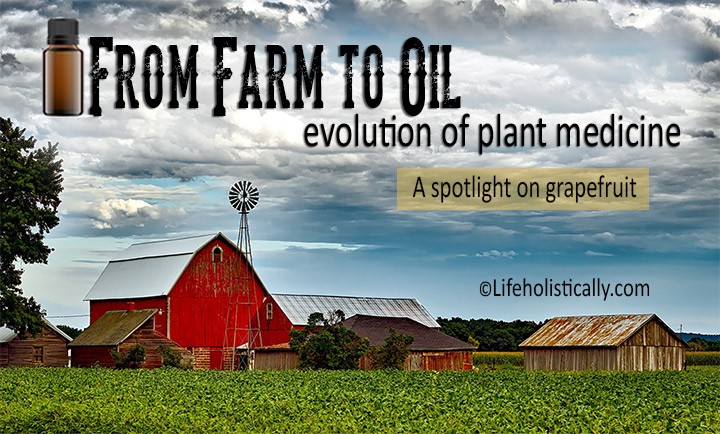
by Leslie Moldenauer | | Essential Oils
The essential oils that we know and love are derived from plants, but this does not necessarily mean that the therapeutic benefits or uses from the plant to essential oil are the same. In many cases, this does not hold true. There are many recipes online utilizing essential oils that do not honor chemistry and do not focus on safe use. Essential oil sustainability is also a massive concern as more and more people are stepping into the essential oil community every day. It is not necessary to use oils every day, or in everything. When we see a recipe shared online, we must ask ourselves if it is necessary, shifting the way we currently see these beautiful resources. Today my focus is on grapefruit essential oil: From Farm to Oil: Evolution of Plant Medicine-A Spotlight on Grapefruit
My goal in this series of blogs is to celebrate plants in all of their glory. I will walk you through from farm to oil. Uses, limitations, and fun recipes of each botanical will be covered. Within each article I will discuss the herb, flower, fruit, seed, root, or bark, and finally, the oil. This will be informative and most importantly, FUN!
Today is all about Grapefruit. I will be covering the fruit and its uses, as well as the essential oil, as there are some differences.
Grapefruit (Citrus paradisi)
Grapefruit (Citrus paradisi) essential oil is derived from the rind of the fruit. Unlike lemons that are heavily sprayed with pesticides, grapefruit is not; therefore buying the essential oil in its organic form is not necessary.
It is assumed that taking grapefruit essential oil internally in water will 1-detoxify you/cleanse the body, 2-help you to lose weight, 3-uplift mood.
Let’s pull that apart.…
1-Do essential oils cleanse the body or detoxify you?
A topic that is so incredibly misunderstood is essential oils and detoxification. Do essential oils detoxify you, or specifically your liver? I wish I could see how many mouths are going to drop right now when I say technically some of them can but it is very much not in the way that is talked about in social media or even with certain health gurus that have taken to share all about essential oils. There is A LOT of MISINFORMATION. I want to rephrase ‘detoxification’ and say that essential oils can offer our liver support.
*Remember, essential oils DO in fact contain chemicals much like drugs and pharmaceuticals contain chemicals. Even though oils are derived from plants, once distilled they are not really all natural any longer. Not in the way that we can place them on our skin undiluted or just drop in our mouth without risk.
So when I said a moment ago that essential oils do have the potential to support your liver and provide some sort of detoxification, it is really not what you’re thinking.
Placing essential oils in water is not the ideal way for a few reasons. The first is the risk involved. Since oils are so concentrated and strong..if we do not put them in a carrier oil or a capsule, we put the lining of our digestive tract at risk for irritation, potentially severe. When taking essential oils in water is it reaching the intended target? OR…more than likely is much of it being destroyed by the acidity in your stomach and then pushed through Phase I and Phase II detoxification? Dropping essential oils in your water to drink is frankly a total waste of your oils.
There are very specific oils that have therapeutic qualities called chologogues. Grapefruit is a chologogue.
What are chologogues, and what can they do for us? Chologogues promote the flow of bile [1]. This is a good thing because bile is necessary for the breakdown of fat. If we are utilizing something to help the flow of bile, we are essentially giving support to our liver…..and by removing fats from the body…we can technically in a round a bout way call it detoxification…this is just not the detoxification we first think of, right?
*Anyone that has liver disease or is currently suffering from gallstones or even has blocked or stopped bile flow, which is called cholestasis, should use caution with these oils [2].
Just remember, the method of use is important. Inhalation or PROPER internal use would be much more effective than in a glass of water. But….the fruit is better than the oil here, hands down! Eat more grapefruit.
**Note….the contraindications to the fruit and the essential oil are different. More on this in a moment.
2-Inhaling grapefruit essential oil can aid in weight loss.
This fact has been extrapolated, a bit. It is recommended in water to achieve this, but we should look to manage cravings due to its sweet scent (this can be construed as helping to not “gain weight” or to help initiate weight loss [3]. So, in order to manage cravings, place grapefruit essential oil in an inhaler and use when you have cravings. This can initiate weight gain by helping you not overeat. This is not achieved by placing drops of oil in your water.
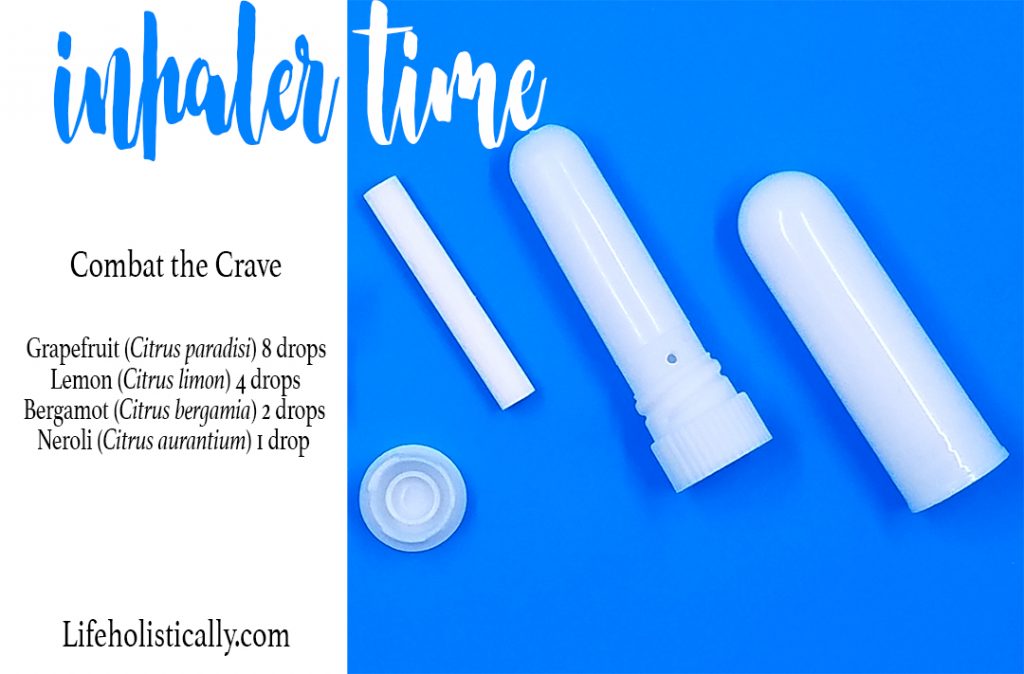
The fruit, however, can initiate weight loss by eating it! Grapefruit is full of nutrients such as vitamin A, C, potassium, lycopene, etc. It is easy to see that grapefruit has a stellar nutrient profile. Perhaps the most impressive is that even though it contains plenty of natural sugar, it is extremely low in the glycemic index (GI) so it does not affect blood sugar levels. Many studies suggest that it decreases the risk of heart disease and diabetes, and has been proven to help you to lose weight [4].
Can you begin to see the complexity of misinformation out there?
3-Inhaling grapefruit essential oil can uplift mood.
This is absolutely true!!! Ding Ding.
A study published in 2002 by the Japanese Journal of Pharmacology showed that inhaling the scent of grapefruit was uplifting to mood [5]. Yet, another fantastic reason to get this oil in an inhaler or diffuser.
Grapefruit has a number of contraindications with various drugs. Learn more about that here.
The essential oil is not the same. According to Robert Tisserand, Grapefruit is slightly phototoxic (max dermal level 4%), but does NOT have the same drug interactions as the fruit.
For more details on grapefruit, refer to Tisserand’s, Essential Oil Safety 2e.
Closing
When we take from the earth for nutrition, sustenance, and healing, it is important that we always consider not only the impact of our use but on giving back. In an ideal world, if we all gave back a little bit more than we take, the impact would be massive. As you can see here with grapefruit, the uses and cautions from fruit to oil are very different.

Like so many practices in life, I encourage you to become educated on the proper use of essential oils. When using them, please do so cautiously, understanding that there is often misinformation on the internet. You can be assured that I support only educated and proven resources. While essential oils should not be feared they should be respected and used properly to ensure the safety of the individuals using them.
Please note that I am not a medical practitioner. The content of this website is provided for general informational purposes only and is not intended as, nor should it be considered a substitute for, professional medical advice. Do not use the information on this website for diagnosing or treating any medical or health condition. If you have or suspect you have a medical problem, promptly contact your professional healthcare provider. By using this website, you assume full responsibility and liability for your own actions.
References
[1] Chologogue definition Retrieved from https://thenaturopathicherbalist.com/herbal-actions/b-d/cholagogue/
[2] Chologogue collection Retrieved from https://iliveok.com/health/cholagogue-collection_89768i15828.html
[3] Shen, J. et.al (2005) Olfactory stimulation with scent of grapefruit oil affects autonomic
nerves, lipolysis and appetite in rats.Science Direct. 289–294
[4] Hawrelak, J., Myers P. Grapefruit Causes Weight Loss. Journal of Complementary Medicine. Vol. 6, No. 1, Jan/Feb 2007: 76-77
[5] Haze, S. et al (2002) Effects of fragrance inhalation on sympathetic activity in normal adults. The Japanese journal of pharmacology. https://www.jstage.jst.go.jp/article/jjp/90/3/90_3_247/_article/-char/ja/
BEFORE YOU GO! Remember to sign up for my FREE Facebook group! Hang out with me and THOUSANDS of other Essential Oil lovers looking to learn, click on to join Real Essential Oil Education Group!
Check out my FREE offer below!
The Differences Between Essential Oil Cautions and Contraindications
Differences Between Plants and Their Essential Oil
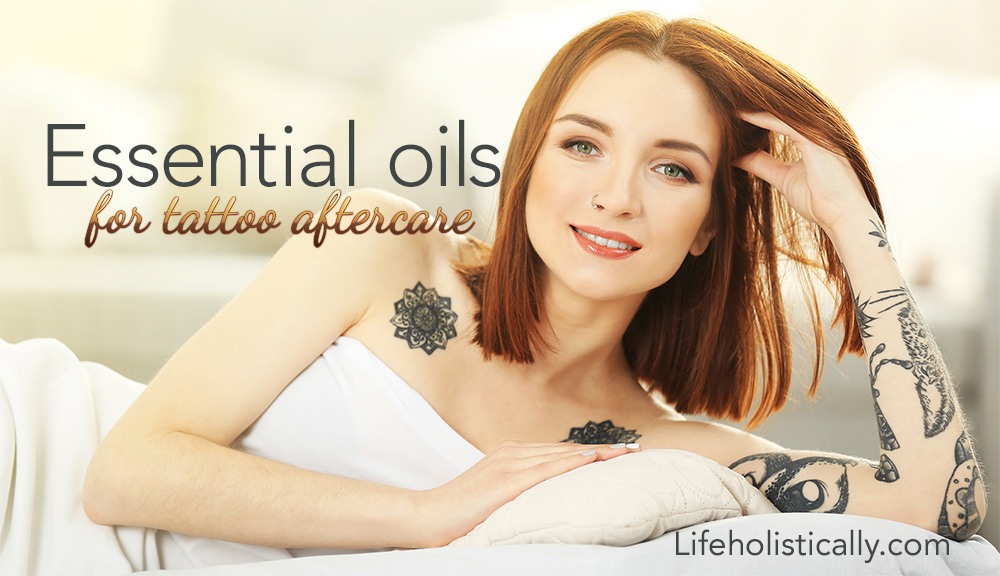
by Leslie Moldenauer | | Essential Oils
The tradition of tattoos has been around for thousands of years, and in the last couple of decades has really been accepted as mainstream. A Harris poll in 2012 found that 1 out of every 5 adults (21%) has at least one tattoo, and those numbers are significantly higher today [1]. Tattoos are a form of self-expression, enabling the body to become a canvas of sorts, a work of art.
Tattoo aftercare is important to avoid possible infection. Although it is rare, it does happen, oftentimes from improper aftercare or issues with the ink itself. One should not simply grab a lotion off the store shelf, or utilize a petroleum-based product.
After an individual gets a tattoo, they are sent home with aftercare instructions that include making sure the tattoo has room to breathe, keeping the area clean and moisturized at all times, using only the product that the artist recommends, avoid sun and chlorine and various other pieces of important instructions.
Unfortunately, over the years, individuals have used said petroleum-based products, which can trap dirt and germs and can be the exact cause of the infection that new tattoo owners are trying to avoid.
Can we utilize herbal and essential oil concoctions to not only heal a tattoo faster but also help to retain color vibrancy and skin integrity? Quality information regarding utilizing botanically based products as a part of skin care after a tattoo is not talked about often, therefore I thought it was very important to reach out to others in the community to find out its history. Professional experience speaks volumes to its safety and effectiveness.
I was honored to find two brilliant practitioners with years of the exact experience we need to have a clear picture. They are both very excited to share with all of us their findings.
For those that are not familiar with you or your work, can you introduce yourself and tell everyone a little bit about what you do?
Hello! I am Vivienne Campbell and am an herbalist. I’ve worked here in Ireland since I qualified 15 years ago. I run a clinic, teach herbal medicine, wild food foraging, and natural cosmetic-making. I also teach these world-wide via my online video course. Over the years I’ve formulated and produced professional natural skin care products for retail for myself and other brands. I also work very closely with clinical aromatherapists. I gave a lecture at the first ever Botanica conference back in 2012 and have been involved with them ever since. I have also interviewed with the producers of the upcoming aromatherapy documentary. They filmed one of my herb walks and interviewed me about herbs, essential oils and sustainability issues (I’m passionate about organics and sustainability issues, having taught classes at an organic seed bank since 2004). There’s heaps of info on my website, The Herbal Hub.

My name is Gillian Parkinson, I live in Roxburgh, Central Otago, New Zealand. My love for essential oils began about 25 years ago, in 2009 I decided to make it official and began my official studies with AromaFlex, studying Cert. Aromascience, this was a 770+ course which I absolutely loved. I graduated end of 2010.
My company Le’Esscience was born, I have a private practice where I provide a massage service, consultation & blending essential oil products. I also have 2 online stores where I make products and ship them worldwide.
I have a few stand out products (all developed by me, I have huge ethics and will not copy anyone’s recipes), to name three, Puppps Relief (a blend that assists in relieving symptoms for a distressing pregnancy rash), MendBlend, first aid blend and TINKture Tattoo Aftercare.

I wanted to talk a little bit today about utilizing essential oils topically for tattoo aftercare. There is not much by way of research or documentation regarding using essential oils in this manner. What is your experience here?
V.C.-Like some of the best things in life, I got into treating this by accident! I don’t have any tattoos but one of my patients was really into them and back in 2004 he asked me to try to make an aftercare product. I met his tattoo artist and he showed me what they used and asked me to try to make something similar. He was buying a natural ointment from the USA, but back then not much was known about tattoo aftercare and most tattoo artists were telling their clients to apply Preparation H, a hemorrhoid cream! I explained to them that this would be more likely to slow down healing rather than help it to happen.
I made a gentle natural ointment using carrier oils and herbal infused oils that traditionally help the skin to heal and prevent scarring. I also included some essential oils to add antiseptic properties to try to prevent infection and to give the product an appealing fragrance. I used rosemary, lavender, frankincense, and sandalwood (it just goes to show how long ago this was: it was before I learned about the sustainability issues of using sandalwood oil).
G.P.- I have around 8 years’ experience in this particular field now, being heavily tattooed myself, I’ve worked in the industry since I developed TINKture.
I decided to develop a tattoo aftercare product to use personally due to the lack of a product that actually aided and sped the healing process, I bruise like a plum and swell so I wanted something to help with that as well so I made my own back in 2010. My tattoo artist was so impressed he said I had to do something with it, so I requested around 20 testers, feedback was incredible, and there were no negative reactions so 6 months later I put it to market. TINKture has a real point of difference due to the fact it actually aids and speeds the healing process, it doesn’t just soothe the area, it has analgesic, anti-inflammatory, antiseptic properties and assist with the itchy stage too.
I can also help (along with antihistamine support) when someone has an allergic reaction to ink, I have experienced this and it is unpleasant and can be very painful. I have great hints and tips to get through this stage, still using TINKture as well as antihistamines and covering and washing for 7-10 days.
I have sold thousands of bottles now, and the feedback has been incredible.
Some individuals are really unsure if this is a safe practice. Why are you confident in employing them in this manner? Have you ever received any negative feedback?
V.C-Well firstly, I was asked by the tattoo artists to do this. It was their idea, not mine so I wasn’t going into it blindly. The confidence came from their feedback. The artists loved the product because they found that it preserved the colours and lines of their artwork much better than other products or no aftercare at all. If the skin doesn’t heal properly then this impacts on the artwork so well-healed skin=a better-looking tattoo and that is better for the tattoo artist (the artists I worked with won several awards). Over the years that I made this for them (6 years), I made thousands of jars of this ointment. Yes, some people had reactions to it but that is to be expected when you are dealing with numbers this high. Occasionally someone would be allergic to one of the ingredients. The recommendation would be to wash it off immediately and go back to their tattoo artist for alternative care advice. The tattoo artists were very helpful in these situations: some of their customers were allergic to the ink too! It just has to be dealt with sensibly.
When it comes to applying aftercare, less is more. A thin layer of ointment applied regularly is the thing that we found worked best for skin healing, rather than slathering on a huge amount and stopping the skin from being able to breathe. The tattoo has to be gently washed before each application of ointment. If people don’t do this then they can trap germs, it gets infected and ultimately this is more work for the tattoo artist because the tattoo gets damaged when the skin doesn’t heal properly and they need to spend additional time doing repair work on the tattoo.
The tattoo artists loved this product because when people used it their work looked better, the colours were brighter, the tattoos lasted in peak condition for longer and it reduced the number of time (unpaid hours) that they had to spend fixing work that had been damaged by insufficient aftercare treatment.
G.P.- It is safe if it is made correctly, using essential oils suitable for wound healing, don’t have contraindications (pregnancy, health conditions etc) the correct dilution, the appropriate carrier oils, directions are followed and storage and shelf life is respected.
I haven’t had ‘negative’ feedback per say, I have had people confuse reactions to allergies to ink, I’m so schooled on this subject and can tell the difference. I help any customer by asking them to send me photos of what’s happening, usually, once I see the photo, I can tell what’s going on. Inks have improved over the years, but there are still artists that ‘cut their own ink’ and use things like liquid soap, mouthwash, witch hazel, propylene glycol to cut ink, also some inks have metals in them, so mostly, it’s these ingredients that people react to. TINKture can help with settling the symptoms.
I can honestly say, I have never been told of an actual allergic reaction, it is rare if someone isn’t already sensitized to essential oils (due to incorrect or overuse) and the product has been blended correctly.
Below is a review from one of my stockiest – I didn’t request this, he just wrote it unprompted
“As a tattoo studio owner and after tattooing for over 10 years now I can honestly say this is the best product I have come across for healing tattoos. I have tried many over the years with varying results and my wife and I agree, this is the product we will be stocking and recommending to our clients. We have used it and stocked it for some time now. We were so impressed with both the product and the lovely people behind it that my wife wanted to model for the promo. So she did. That’s my beautiful wife in the poster. That’s how much we believe in the product. Check it out for yourself.”
Lampin
Lampin Ink
I assume this is not a one size fits all situation. Is there anything that you want to include on the topic? Are there specific oils that we should stay away from? What would you like everyone reading this to know regarding essential oils and tattoo aftercare?
V.C-Absolutely. No ingredient (natural or synthetic) suits everyone in the world and there will always be someone who will react to something, no matter how gentle the ingredients. Don’t panic if this happens, just wash it off and don’t use a product containing that ingredient again.
*Make something gentle. It’s not a disease or a massive infection that you are trying to treat.
*Use a very low percentage of essential oils: this product doesn’t need to be strong.
*Use fixed and herbal infused oils that are gentle.
*Avoid calendula infused oil: I know it’s recommended for skin healing but it seems to irritate and aggravate skin conditions in about 1 in ten people from what I’ve seen. It can heat up a wound and worsen it. A tattoo artist from the Netherlands that I worked with found this too and used to avoid natural aftercare products containing this oil.
*Legal work for retailing this product: depending on which country you are in, you may need to do some lab work to get it tested and approved as a retail cosmetic product. This is certainly the case now in EU countries. However, don’t worry about this. Products made from oils, butter and waxes (i.e. water-free products) are straightforward and relatively inexpensive to get tested and assessed by a cosmetic chemist. Depending on which country you are in and the rules there, you’ll need this work done so that you are insured for making this as a legal retail product. If you simply want to make some for some clients who attend your aromatherapy clinic then you shouldn’t need to do this because it should be covered like any other treatment you do there.
Thanks for asking me to talk about this. I made this product for tattoo artists in Ireland for years until the recession here got very bad and some of the studios started to close down. It was a beautiful product to make (it smelled fantastic!), I had great fun doing all the graphic design work for it, taking photos of the tattoos and collecting testimonials. I think you’ve given me the nudge I needed to start making it again so watch this space!
G.P.- I think THE most important factor is to find out if the essential oil aftercare (well any aftercare actually) you are using (which doesn’t come from a large manufacturer ie nappy rash creams, which I don’t recommend using) has been developed and made by someone with professional qualifications in that field, this is VITAL as unqualified people will not understand adverse reactions, contraindications :ie using beeswax or sweet almond oils, useless & potentially dangerous for anyone with bee or nut allergies, essential oil safety, the actual active properties of the ingredients, if it’s safe if it gets in the wrong hands (a child, pregnant woman etc). This includes people who just google, hobbyists, tattoo artists even, resellers of products that may be suitable to use but have no official experience in blending or understand the process of wound healing. If you are unsure, ask questions – the qualified practitioner will not hesitate in reassuring you.
I would never use peppermint, tea tree, rosemary specifically but importantly, essential oils that are not suitable for wound healing – and nothing more than 2-3% dilution.
It truly also helps, if the person making the products, yes, has the qualifications, but is also tattooed, in many places! – I have learned SO much about how different areas heal differently, healing tattoos in the summer is different from healing tattoos in the winter, certain fabrics irritate healing ink, the weather, your health too, if you are sick, you should not get tattooed, if you do, expect it to take longer to heal, if you have a health condition, such as fibromyalgia, expect your ink to take longer to heal – I developed TINKture with all these variables in mind, making it a safe, reliable and extremely effective natural (& vegan) product to aid & speed the healing process.
It all counts!
I would like to thank Vivienne and Gillian for sharing their expertise with us. Understanding the years of training and wisdom that are behind formulating essential oils for tattoo aftercare helps us tremendously.
There is an inherent risk of applying a product not recommended by a professional versed in skin care formulating. Both of these amazing professionals make a product very specific to the tattooed skin based on a lot of education and experience. I would discourage a home user from attempting to blindly blend something for their own use or seeking advice from a Pinterest image. Please seek advice from someone with significant knowledge on the subject.

Reference
[1] http://www.pewsocialtrends.org/2010/02/24/millennials-confident-connected-open-to-change/
BEFORE YOU GO! Remember to sign up for my FREE Facebook group! Hang out with me and THOUSANDS of other Essential Oil lovers looking to learn, click on to join Real Essential Oil Education Group!
Check out my FREE offer below!
















